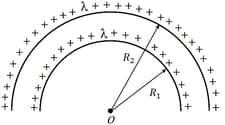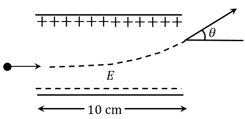EASY
JEE Main
IMPORTANT
Earn 100
Two identical thin metal plates has charge and respectively such that . The plates were brought close to each other to form a parallel plate capacitor of capacitance . The potential difference between them is :
(a)
(b)
(c)
(d)
50% studentsanswered this correctly

Important Questions on Electrostatics
MEDIUM
JEE Main
IMPORTANT
An particle and a proton are accelerated from rest through the same potential difference. The ratio of linear momenta acquired by above two particles will be :
MEDIUM
JEE Main
IMPORTANT
If two charges and are separated with distance and placed in a medium of dielectric constant . What will be the equivalent distance between charges in air for the same electrostatic force?
MEDIUM
JEE Main
IMPORTANT
A stream of a positively charged particles having and velocity is deflected by an electric field . The electric field exists in a region of along direction. Due to the electric field, the deflection of the charge particles in the direction is _____ .
MEDIUM
JEE Main
IMPORTANT
The electric potential at the centre of two concentric half rings of radii and , having same linear charge density is

EASY
JEE Main
IMPORTANT
A parallel plate capacitor with air between the plate has a capacitance of . The separation between the plate becomes twice and the space between them is filled with a medium of dielectric constant . Then the capacitance becomes . The value of is____.
EASY
JEE Main
IMPORTANT
A parallel plate capacitor has plate area and plates separation . The space between the plates is filled with a dielectric medium of a thickness and dielectric constant . The capacitance of the system is:
MEDIUM
JEE Main
IMPORTANT
A uniform electric field of is created between two parallel charged plates (as shown in figure). An electron enters the field symmetrically between the plates with a kinetic energy The length of each plate is . The angle of deviation of the path of electron as it comes out of the field is ______(in degree).
EASY
JEE Main
IMPORTANT
A point charge of is placed at the origin. At what location on the -axis should a point charge of be placed so that the net electric field is zero at on the -axis ?

